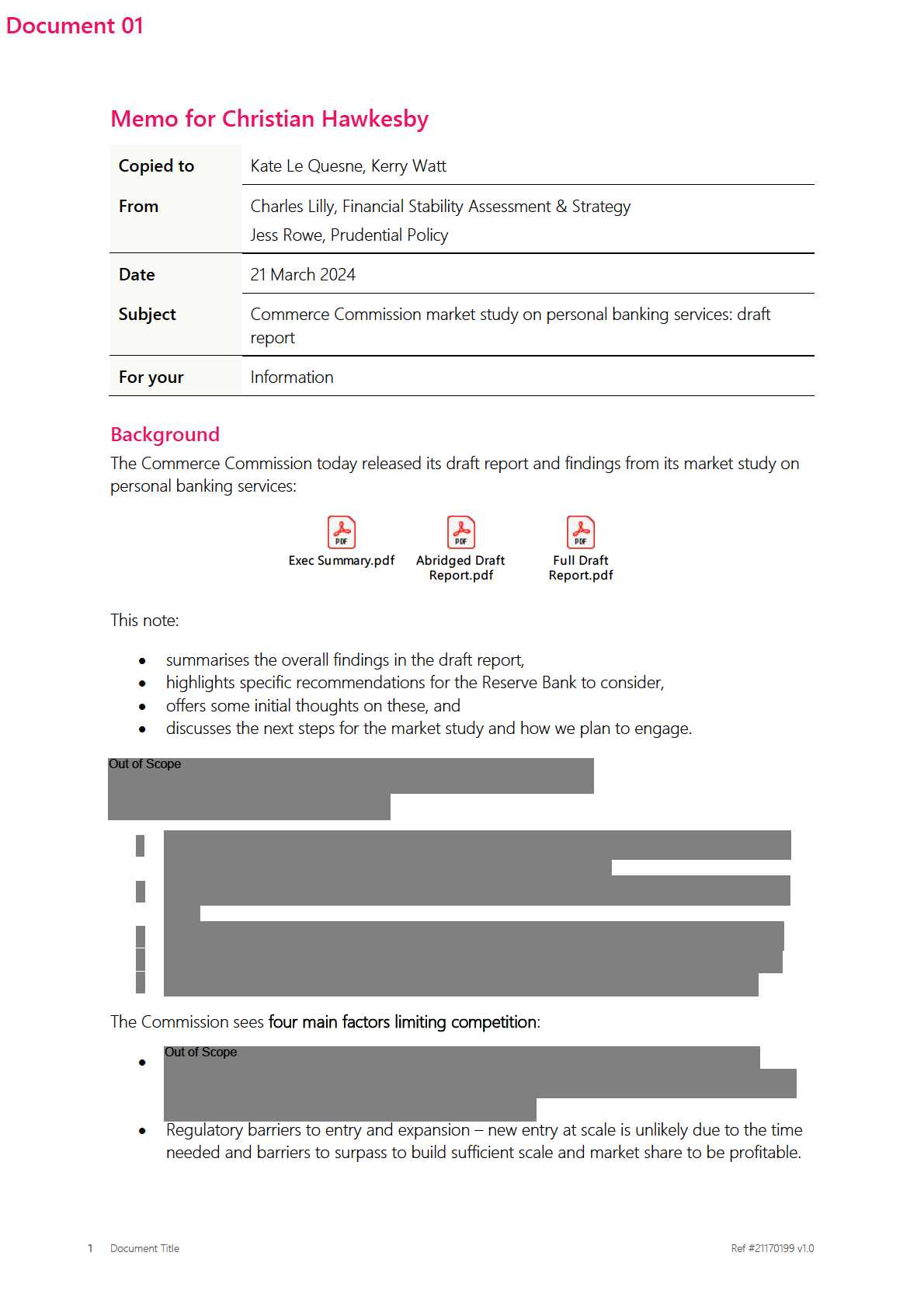
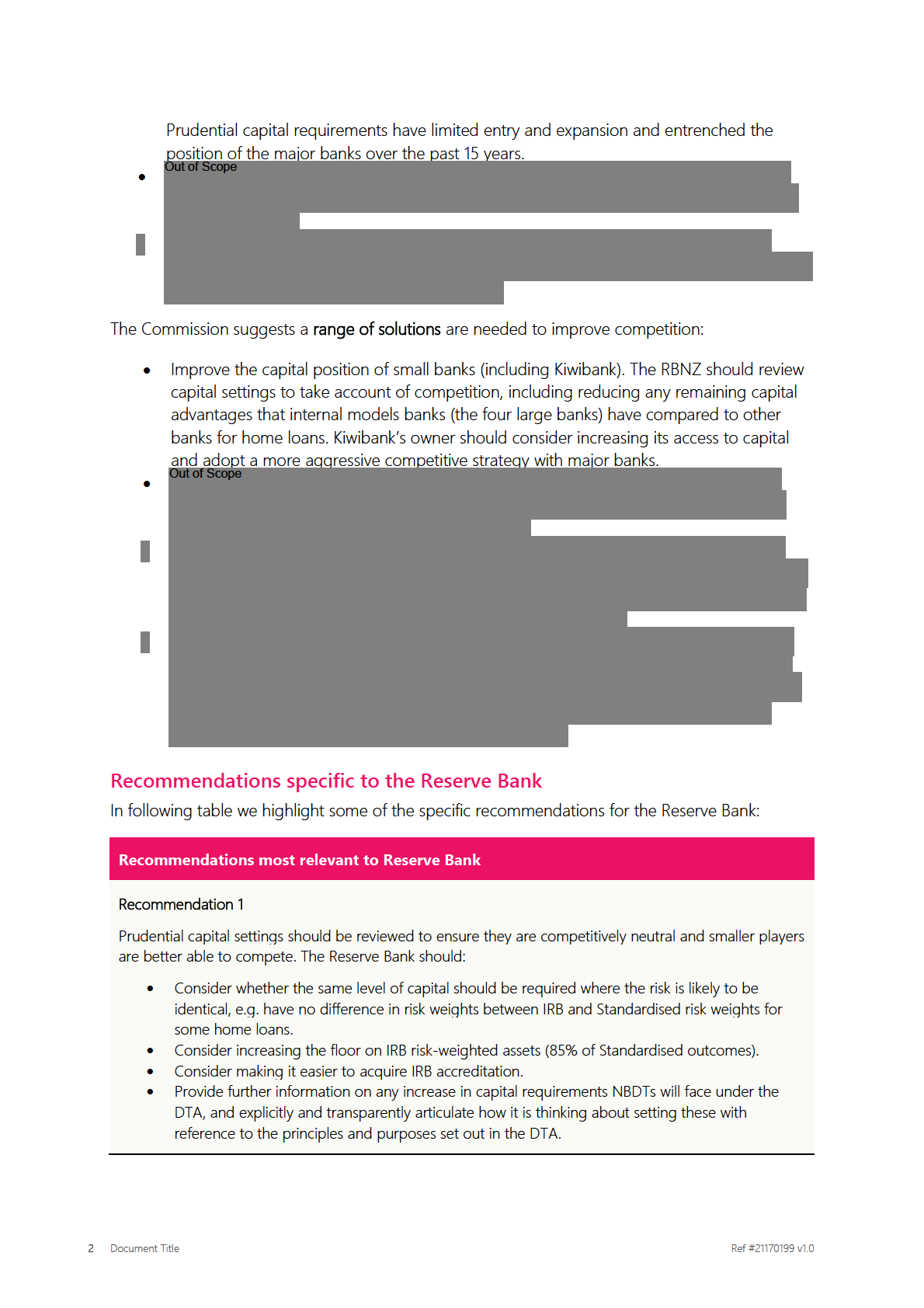

 Initial thoughts on recommendations
Initial thoughts on recommendations
Our initial impression is the report is somewhat unbalanced, lacking a holistic quantitative
assessment of the impact of prudential requirements on competition, and is silent on the expected
scale of benefits of changes in regulation, including in relation to the other areas covered in the
recommendations. It tends to focus on specific elements such as risk weights in limiting
competition but dismissing the impact the D-SIB buffer - which our analysis suggests largely
cancel each other out. The report also seems to underplay how we already, and will continue to,
consider competition elements within our policy development and that fact that competition is one
of many principles we legally need to consider in pursuing our primary objective of promoting
financial stability.
Capital requirements (recommendation 1) are highlighted as an ongoing competitive barrier,
despite the significant changes made as part of the Capital Review (85% floor on IRB models, 2%
DSIB buffer requirement). While there is still a difference in capital outcomes between the large and
small banks, the report doesn't provide much detail on the materiality of this in terms of the extent
to which it affects the average cost of banks' funding.
We provided the Commission with some illustrative estimates of the impact that the capital
differences imply for banks' loan pricing, which suggested the difference in capital requirements
could amount to c. 9bps prior to the Capital Review changes, and ?bps afterwards (0bps if the
DSIB buffer is also factored in). The draft report places a lot of emphasis on the difference in capital
requirements and how this acts as a barrier to competition but doesn't include quantitative
estimates of the impact further "levelling of the playing field" would have on small banks' ability to
offer more competitive loan pricing.
Process and next steps
The draft report is open for submissions until the 18th of April. Following this, the Commission will
hold a conference to discuss the draft report with stakeholders and experts between 13th to 16th
May. The conference format is a combination of open and confidential sessions in which
Commission staff discuss their findings and recommendations and ask specific questions of
interested parties and experts.
A final report is due to be published on 20th August. Under the Act, the Minister of Commerce and
Consumer Affairs is required to respond to the final report within a reasonable timeframe following
its publication.
FSG Directors are establishing a small team to draft a more thorough response which, subject to
further discussion, may become a formal submission on the draft report (including our legal,
financial inclusion and ESAS colleagues). We have also reached out to the Treasury team leading
3 Document Title
Ref #21170199 v1.0

Document 02
From:
Michaela Halse
To:
Richard Downing; Charles Lilly
Subject:
FW: ComCom study - topics from recommendation 1 Monday, 25 March
Date:
2024 5:20:36 pm
Attachments:
image001.png
image002.png
image003.png
image004.png
image005.png
image006.png
Richard/Charles
Further to my initial email, I have noted the paragraphs which set out the specific elements of
the recommendation. I’m not sure if either of you have started putting together a response
on this recommendation, but happy to make a start now that we have a word limit. The IRB
regime recommendations would justify the majority of the focus, with the NBDT
recommendation being able to be dealt with by way of largely referencing the upcoming
consultation. So the question is how much focus (if any) do we want to give to topics not
explicitly covered in the recommendation section?
IRB regime:
Paragraph 10.9 explains that this draft recommendation includes that the RB s
hould
review the role and the operation of the IRB regime for home loans as part of the
upcoming consultation on the Capital Standard later this year to ensure that the same
level of capital is held where the risk is likely to be equivalent.
Paragraph 10.9.1 further states that the RB should
consider whether the same level of
capital should be held where risk is likely is likely to be identical (regardless of whether
the lender is IRB accredited).
Paragraph 10.9.2 then suggests the RB should
consider making it easier to acquire IRB
accreditation.
NBDTs:
Paragraph 10.12 states the RB should
provide further information about its views on the
prudential requirements that NBDTs may have under the DTA including the policy
reasons for proposed changes to the status quo, and to do so with explicit reference to
the purposes and principles of the DTA.
Other:Paragraph 7.56.4 omits reference to
Mutual Capital Instruments and references an out of
date version of BPR120.
Paragraph 7.59.2.2 suggests the
output floor could be set higher (this is 1 of the 3
examples given of whether there should be adjustments to the current capital settings –
the other 2 examples were included in the recommendation section – paras 10.9.1 and
10.9.2)
Paragraph 7.55 referring to the
entrenched competitive advantage due to the capital
settings since 2008
Thanks
Michaela

 From:
From: Michaela Halse
Sent: Friday, March 22, 2024 2:21 PM
To: Richard Downing <[email address]>; Charles Lilly
<[email address]>
Subject: ComCom study- topics from recommendation 1
At Richard's request, I've pulled out some themes from the first recommendation as a starter:
IRB regime
• Entrenched competitive advantaQe - there is no recommendation here but an
underlying theme is that we are where we are due to RB regulation (especial y IRB
modelling) from 2008 on. We could ignore, or acknowledge noting this was flagged
during the Capital Review and the changes would go towards redressing some of the
perceived imbalance.
• ModellinQ - in particular, the recommendation suggests certain home loan exposures
shouldn't be modelled.
• IRB accreditation - the recommendation is that this should be easier.
• Output floor - the main body of the report also suggests we could consider raising the
output floor (7.59.2.2) but this doesn't seem to have flowed through to the
recommendation section
• Broader review - the recommendation that we should include a review of the IRB
regime fpo home loans as part of this year's standards consultation feels disingenuous
as it would be impossible to do so from a practical sense. This might need addressing
from an external stakeholder expectation management perspective .
•
There are various small issues that were raised in chapter 7 of the report that do not lead to
any specific comment in the recommendation section. For example:
• Para 7.56.4 - there doesn't seem to be acknowledgement of the introduction of MCls:
they have referred to an out of date version of BPR120 (July 2021) which predates the
October 2023 version which was revised to include MCls.
• The focus is quite heavily on the output floor and the DSIB buffer. There is only a
passing reference to the scalar. Also its quite a nuanced point, and it depends on how
frequently we expect the output floor to be triggered, but the cap review sought to
impact RWA by combining reductions to the exposures that can be modelled with the
scalar and the output floor, and so it feels the report's focus on the output floor is a bit
simplistic.
Thanks
Michaela
Michaela Halse
Senior Analyst, Financial Policy
Reserve Bank of New Zealand - Te Patea Matua
Level 13, Tower Two, 205-209 Queen St, Auckland 1010
PO Box 5240, Victoria St West, Auckland 1142




 E
E [email address]
W rbnz.govt.nz


 Document 04
Document 04
3/26 2:02 PM Michaela Halse
Hi Charles Lilly, as an FYI I've spoken with Richard this afternoon and agreed to start putting
together a draft intro to our response to recommendation 1, and then to put some bullets under
each individual topic identified as part of that recommendation. I'll circulate that later
today/tomorrow morning as a starter.
3/26 3:13 PM Michaela Halse
Here is the document I referred to in my previous message. It includes a generic intro and then
breaks down the main parts of the recommendation with some bullets. Please let me know what
you would like me to build out further and/or if there are other areas to consider.
Draft recommendation 1 response framework.docx
3/27 1 :53 PM Richard Downing
Hi Michaela. I will have a look at those notes you sent around. Looks like they are on teh right
track. There is nothing else waiting on completion from my perspective, unless there are
particular things Charles wants you to pick up.
3/27 1 :54 PM Michaela Halse
Thanks Richard - I saw your comments on the intro so will deal with those now
3/27 1 :55 PM Richard Downing
.__________ __, For that section I would just keep it general
3/27 2:11 PM Michaela Halse
How general? Avoid mentioning the cap review at all? or just pare it right back to a brief
mention?
3/27 2:12 PM Richard Downing
Referencing cap review is fine, just the detailed principles I would avoid, and focus on the general
idea ie. to meet financial stability objectives
3/27 2:43 PM Michaela Halse
I've revised the intro para - let me know what you think
3/28 9:05 AM Michaela Halse
If you've both had a chance to look at the points in my initial draft, I'll start turning them into
actual prose. If there are other points I should include, or if I have some wrong, please say.
3/28 9:12 AM Richard Downing
Good plan. I have added a few more comments to your document.
3/28 12:36 PM Michaela Halse
I have just about finished drafting a suggested response for of the areas I highlighted. The one
remaining one is the suggestion we should consider whether the same level of capital should
be held where the risks is likely to be identical (irrespective of IRB status). the bullets I noted
included:
•
Conceptual y support removing the ability to model certain exposures where the risk is
likely to be identical.
•
Need to understand scale of any practical issues – ie. can banks isolate relevant exposures.
3/28 12:38 PM Michaela Halse
Neither of you have commented on this - do I take it you agree? Its a fairly big shift from current
practice
3/28 12:39 PM Michaela Halse
Out of Scope
. . otherwise my suggested drafting is all in blue in the
doc linked further above in this chat
[3/28 12:46 PM] Richard Downing
Out of Scope
My
general comment is that we should emphasise that our framework, to the extent it is possible,
aligns credit risk weights to the credit risks that are associated with an exposure. So in principle I
don't see a disagreement with the statement. The "irrespective of IRB status" creates a difficulty
though since it is the extra info from IRB that gives us the confidence that an approved model wil
generate a risk weight aligned with risk. So the use of IRB is central to that assessment, whereas in
the standardised there is less info to give the extra granularity to the risk weight. S once we say
"irrespective of IRB status" it becomes hard to reconcile.
[3/28 12:51 PM] Michaela Halse
I'l put something together - I suspect there is plenty you wil want to change for al of the topics
but hopefully it gives you something to start with. Out of Scope
Out of Scope




4/2 10:28 AM Michaela Halse
11
I
---------------------------------
4/2 10:34 AM Richard Downing
Do you have an updated version of those notes you
---------------
were wor rng on ast wee ? I ave some time to look at that properly today. Otherwise, I am
happy to
wait for Charles for further instruction
4/2 10:49 AM Michaela Halse
The document linked above is in sharepoint so is up to date
4/2 10:50 AM Michaela Halse
let me know if you have issues accessing it
4/2 5:22 PM Charles Lilly
I've been going through the doc this afternoon - thanks both for contributing (especially
Michaela). I've tried to edit down some of the detail and reordered the sections so that the IRB
material is in the same place, I think this helps with the flow. I am also putting in an annex, which
will provide the quantitative example of how little this matters for loan pricing. Mostly this is
taken from the information we sent ComCom via emails which didn't make it into the draft
[4/3 11 :05 AM] Michaela Halse
Just been through and accepted changes to tidy it up. We are currently well over the word limit.
Removing the preface to each section will knock off about 250 words but we are still over 1500.
[4/3 11 :16 AM] Michaela Halse
Richard Downing - are you aware of the data Ian Woolford referred to in relation to costs of
maintaining an IRB framework? If we can access it easily, it would fit nicely with our response to
the IRB accreditation recommendation.
[4/3 11 :43 AM] Richard Downing
Hi Michael. We talked to Commerce Commission about this. I think Charles might have the info
for this.
[4/3 11:44 AM] Charles Lilly
Have just forwarded my notes on this
[4/3 11:58 AM] Michaela Halse
Thanks Charles - Ian referred to specific $ amounts, is that detail we also have? big numbers can
help focus attention...
[4/3 12:11 PM] Charles Lilly
It's not a number I would have any confidence in to put in the submission, it was something we
looked at when we were doing the denominator paper for the Capital Review (around 2018),
was about $8m I think for one of the four banks
[4/3 12:11 PM] Charles Lilly
But that's a very rough number
[4/3 12:11 PM] Michaela Halse
ok - noted
Document 05
These were the notes I made – I would estimate around 10-20 FTE for ongoing IRB
accreditation, plus any systems costs
From: Charles Lilly
Sent: Thursday, January 25, 2024 10:58 AM
To: Kerry Watt <[email address]>; Jess Rowe <[email address]>; Chris Hunt
<[email address]>; David Hargreaves <[email address]>; David Law
<[email address]>; Richard Downing <[email address]>; James Painter
<[email address]>; Angus McGregor <[email address]>; Benjamin
Hammond <[email address]>; Robbie Taylor <[email address]>; Ian
Woolford <[email address]>
Subject: RE: Pre-meet for MBIE meeting
Some notes on the IRB approach
Key messages:
• IRB involves material ongoing operating costs that Standardised banks don’t face.
• Among IRB banks, risk weights don’t vary too much given similar business
strategies/credit risks in the NZ market.
• The output floor and DSIB buffer effectively offset the benefit of lower risk weights
under IRB.
• Any impact of IRB on loan pricing is minor compared to other factors.
More detailed points:
• IRB accreditation is a complex process which entails both setup and ongoing costs
(e.g. developing and validating models, maintaining data systems, additional
reporting requirements, and additional prudential requirements). IRB banks in NZ
would typically have 10-20 local FTE focussed on IRB models and compliance, in
addition to drawing on Group resources.
• It is common for only the largest and most complex banks to be accredited to use IRB
models in most banking markets – e.g. the four largest in NZ, the six largest in
Australia.
• IRB model outcomes can vary between the four IRB banks within different lending
categories, reflecting differences in underlying credit quality as well as modelling
methodologies. The RBNZ must approve any IRB model before a bank is able to use it
in its capital calculation. Our review process involves peer benchmarking and
general y the differences in risk weight outcomes across the four banks are smal ,
which reflects that the four banks’ credit policies and business strategies are fairly
similar to one another in the NZ market.
• Since January 2022 an output floor has applied to IRB banks’ risk-weighted asset
(RWA) calculations which means that RWAs calculated using IRB models can be no
less than 85 percent of the equivalent value that would be calculated using the
Standardised approach used by al other local y incorporated banks. In most
jurisdictions the output floor on the IRB approach is set lower, at 72.5 percent of RWA,
i.e. our framework has a tighter limit on the potential RWA benefit from IRB.
• The four NZ IRB banks are also subject to a domestic-systemically important bank
(DSIB) capital buffer requirement of 2 percent of CET1. While the output floor and
DSIB buffer have distinct objectives and policy rationales, their net effect is that the
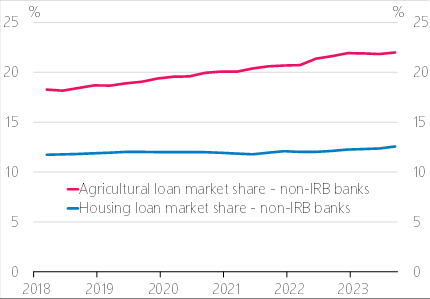
four NZ IRB banks face similar overall capital requirements as the other
locally incorporated banks.
• The difference in RWA outcomes between IRB and Standardised banks could in
theory lead to IRB banks being able to offer lending at a lower cost to borrowers due
to a lower weighted-average cost of funding. However, in practice the extent of any
differential is likely to be very small and we do not consider it to be a major
contributor to loan pricing when compared to other factors such as movements in
banks’ debt funding costs and their operating costs.
o Rabobank NZ, which uses the Standardised approach, is the third largest
agricultural lender and has steadily grown its market share in recent years (see
figure). Under the Standardised approach, agricultural lending has a 100
percent risk weight, compared to an average of around 70 percent under IRB
(before the output floor).
o In our rules residential mortgages for investors have approximately 20 percent
higher capital requirements than owner-occupier loans at a given loan-to-
value ratio, under both IRB and Standardised approaches. We do not observe
differential pricing for investor mortgages in the market, suggesting the
difference in capital requirements has only a minor impact on banks’ loan
pricing behaviour.
Figure: Lending market share of non-IRB banks
Source: RBNZ dashboard
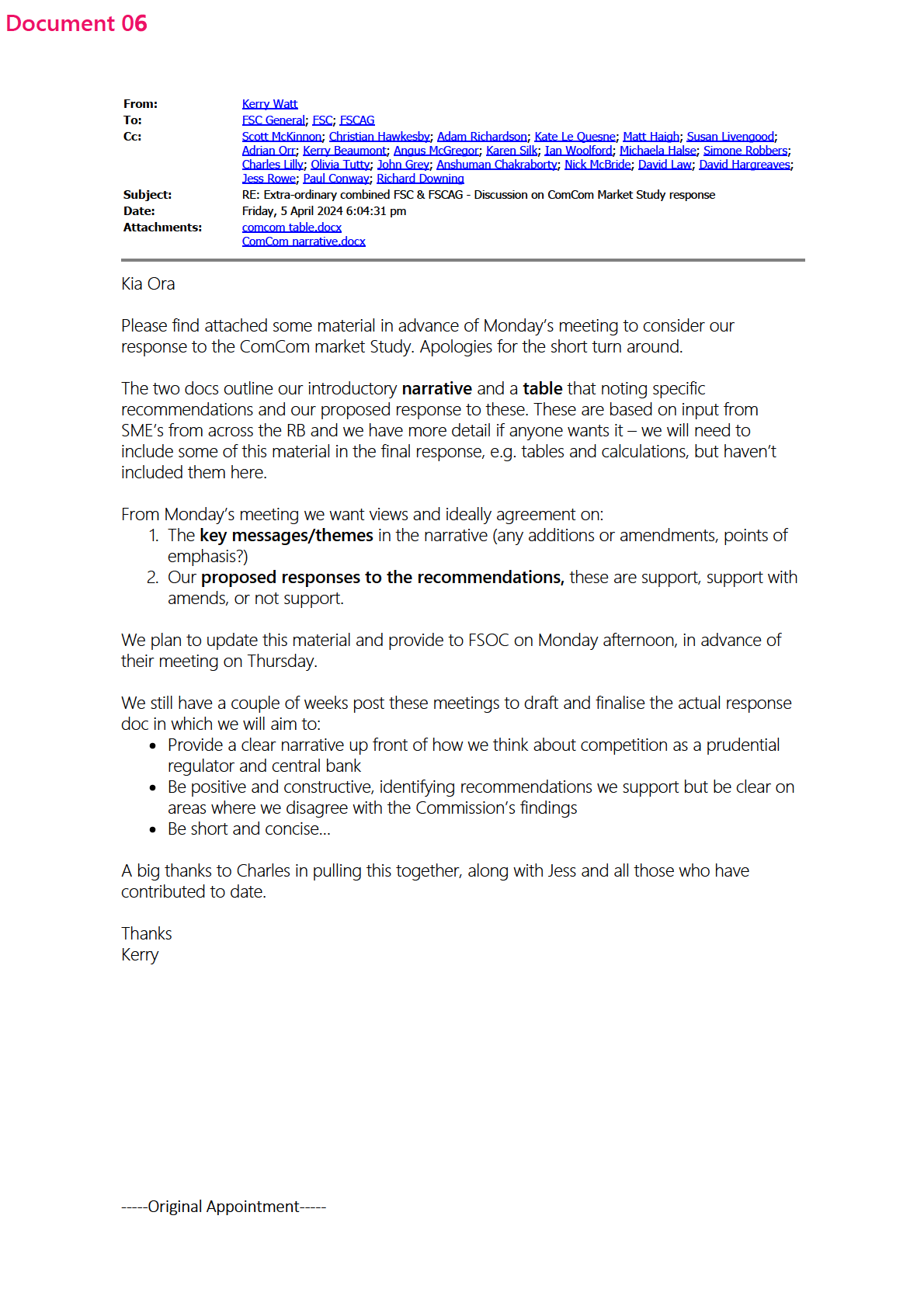
From: FSC General <[email address]>
Sent: Monday, March 25, 2024 1:35 PM
To: FSC General; FSC General; FSC; FSCAG
Cc: Scott McKinnon; Christian Hawkesby; Adam Richardson; Kate Le Quesne; Kerry Watt; Matt
Haigh; Susan Livengood; Adrian Orr; Kerry Beaumont; Angus McGregor; Karen Silk; Ian Woolford;
Michaela Halse; Simone Robbers; Charles Lilly
Subject: Extra-ordinary combined FSC & FSCAG - Discussion on ComCom Market Study response
When: Monday, 8 April 2024 1:00 pm-2:00 pm (UTC+12:00) Auckland, Wellington.
Where: 8th Floor - Aoraki Room - Teams Meeting Room - External; Auckland Office 13th Floor
Waitematā Room (18 Seats)
________________________________________________________________________________
Microsoft Teams Need help?
Join the meeting now
Meeting ID: 445 919 908 245
Passcode: vtheBA
For organizers: Meeting options | Reset dial-in PIN
________________________________________________________________________________
Document 07
From:
Katy Simpson
To:
Richard Downing; Charles Lilly
Cc:
Jess Rowe; Kerry Watt; Michaela Halse
Subject:
RE: Extra-ordinary combined FSC & FSCAG - Discussion on ComCom Market Study response
Date:
Monday, 8 April 2024 9:26:40 am
Attachments:
comcom table - KS comments on the first row.docx
ComCom narrative KS.docx
Thanks for forwarding this on Richard, and well done Charles for your quick work to bring this
together.
I’ve had a quick look this morning and have some comments – mostly on the first row of the
table. I think we should do a bit more there to reinforce the scale of the work we did as part
of the capital review and that implementation is ongoing. I also think we could add in some
footnotes or links to explain some of the technical things, especially where ComCom got
them wrong in the main report – I think this is our main (only?) opportunity to influence on
these points. Where this is not possible before going to FSOC, I wonder if we just add some
placeholder footnotes?
On the key messages section, I’ve put in some ideas for some opening framing and a few
other thoughts, just in case they’re useful – I know you’re under time pressure and will have
comments from others so feel free to ignore of they don’t fit.
Please could I be added to the call at 1?
Thanks
Katy
From: Richard Downing <[email address]>
Sent: Monday, April 8, 2024 8:23 AM
To: Katy Simpson <[email address]>
Subject: FW: Extra-ordinary combined FSC & FSCAG - Discussion on ComCom Market Study
response
Hi Katy – not sure whether you have seen this. I saw the earlier versions, and Charles and Jess
have completed it.
Kerry has sent me the meeting invite. I intend to dial in at 1pm.
Richard
From: Kerry Watt <[email address]>
Sent: Friday, April 5, 2024 6:04 PM
To: FSC General <[email address]>; FSC <[email address]>; FSCAG
<[email address]>
Cc: Scott McKinnon <[email address]>; Christian Hawkesby
<[email address]>; Adam Richardson <[email address]>; Kate
Le Quesne <[email address]>; Matt Haigh <[email address]>; Susan
Livengood <[email address]>; Adrian Orr <[email address]>; Kerry
Beaumont <[email address]>; Angus McGregor
<[email address]>; Karen Silk <[email address]>; Ian Woolford
<[email address]>; Michaela Halse <[email address]>; Simone Robbers
<[email address]>; Charles Lilly <[email address]>; Olivia Tutty
<[email address]>; John Grey <[email address]>; Anshuman Chakraborty
<[email address]>; Nick McBride <[email address]>; David
Law <[email address]>; David Hargreaves <[email address]>; Jess Rowe
<[email address]>; Paul Conway <[email address]>; Richard Downing
<[email address]>
Subject: RE: Extra-ordinary combined FSC & FSCAG - Discussion on ComCom Market Study
response
Kia Ora
Please find attached some material in advance of Monday’s meeting to consider our
response to the ComCom market Study. Apologies for the short turn around.
The two docs outline our introductory
narrative and a
table that noting specific
recommendations and our proposed response to these. These are based on input from
SME’s from across the RB and we have more detail if anyone wants it – we will need to
include some of this material in the final response, e.g. tables and calculations, but haven’t
included them here.
From Monday’s meeting we want views and ideally agreement on:
1. The
key messages/themes in the narrative (any additions or amendments, points of
emphasis?)
2. Our
proposed responses to the recommendations, these are support, support with
amends, or not support.
We plan to update this material and provide to FSOC on Monday afternoon, in advance of
their meeting on Thursday.
We still have a couple of weeks post these meetings to draft and finalise the actual response
doc in which we will aim to:
Provide a clear narrative up front of how we think about competition as a prudential
regulator and central bank
Be positive and constructive, identifying recommendations we support but be clear on
areas where we disagree with the Commission’s findings
Be short and concise…
A big thanks to Charles in pulling this together, along with Jess and all those who have
contributed to date.
Thanks
Kerry
-----Original Appointment-----
From: FSC General <[email address]>
Sent: Monday, March 25, 2024 1:35 PM
To: FSC General; FSC General; FSC; FSCAG
Cc: Scott McKinnon; Christian Hawkesby; Adam Richardson; Kate Le Quesne; Kerry Watt; Matt
Haigh; Susan Livengood; Adrian Orr; Kerry Beaumont; Angus McGregor; Karen Silk; Ian Woolford;
Michaela Halse; Simone Robbers; Charles Lilly
Subject: Extra-ordinary combined FSC & FSCAG - Discussion on ComCom Market Study response
When: Monday, 8 April 2024 1:00 pm-2:00 pm (UTC+12:00) Auckland, Wellington.
Where: 8th Floor - Aoraki Room - Teams Meeting Room - External; Auckland Office 13th Floor
Waitematā Room (18 Seats)
________________________________________________________________________________
Microsoft Teams Need help?
Join the meeting now
Meeting ID: 445 919 908 245
Passcode: vtheBA
For organizers: Meeting options | Reset dial-in PIN
________________________________________________________________________________
Document 08
[…]
Recommendation 1 (prudential settings)
The committees considered this was a good place to give global context, that its not credible to
‘throw IRB out the window’. Comments also covered maybe giving some context around non-IRB
banks as a footnote, to note where banks currently sit in relation to the output floor (c 90s%), also
to provide more detail about how resource intensive IRB model ing is (though it was noted that we
had previously provided ComCom with this type of information).
[…]
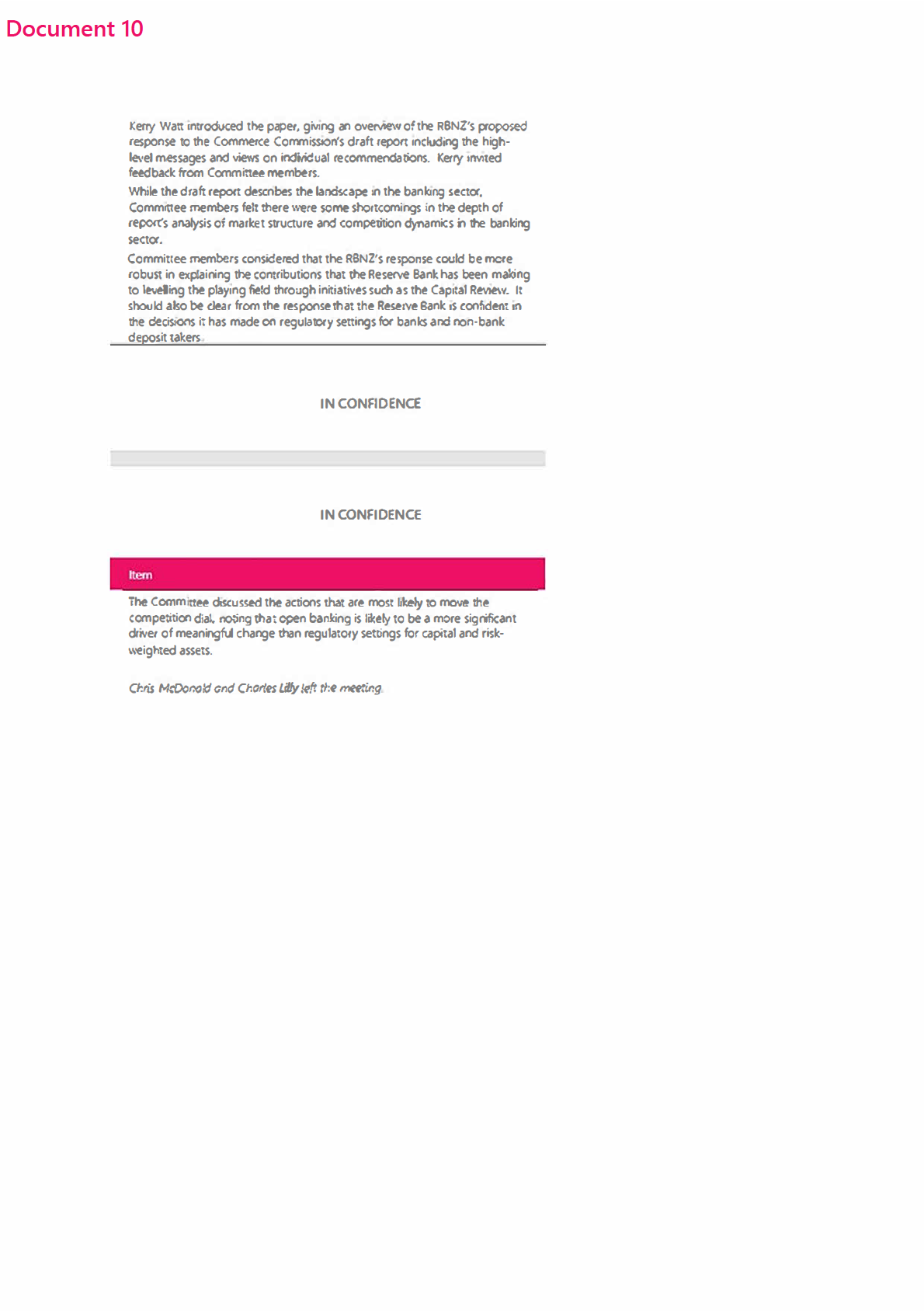
Document 11
From:
Katy Simpson
To:
Richard Downing; Michaela Halse
Subject:
RE: Extra-ordinary combined FSC & FSCAG - Discussion on ComCom Market Study response
Date:
Monday, 15 April 2024 2:12:25 pm
Attachments:
ComCom Market Study Draft Report - RBNZ submission KS.docx
Hi both
I’ve attached my thoughts in the attached. Happy to discuss and combine our comments if
that works?
My only remaining niggle is whether there is anything we can do to pre-empt the ComCom
line that the 2% D-SIB buffer is there for a different reason and therefore shouldn’t count in
the comparison of IRB and standardised approaches? I think they’re saying that DSIBs should
hold more capital (to internalise their possible externality?), but in effect we’re allow them to
hold the same as non-DSIBs because they get to do IRB modelling. Is our line that because
IRB leads to better risk management, we’re comfortable if they end up in a similar place than
they would be without the DSIB buffer under the standardised approach – the IRB modelling
is reducing the risk/externality? I don’t think that really comes across – but maybe that’s fine…
Thanks
Katy
From: Kerry Watt <[email address]>
Sent: Monday, April 15, 2024 9:40 AM
To: FSC <[email address]>; FSCAG <[email address]>
Cc: Scott McKinnon <[email address]>; Christian Hawkesby
<[email address]>; Adam Richardson <[email address]>; Kate
Le Quesne <[email address]>; Matt Haigh <[email address]>; Susan
Livengood <[email address]>; Adrian Orr <[email address]>; Kerry
Beaumont <[email address]>; Angus McGregor
<[email address]>; Karen Silk <[email address]>; Ian Woolford
<[email address]>; Michaela Halse <[email address]>; Simone Robbers
<[email address]>; Charles Lilly <[email address]>; Anshuman
Chakraborty <[email address]>; Nick McBride
<[email address]>; David Law <[email address]>; David Hargreaves
<[email address]>; Jess Rowe <[email address]>; Paul Conway
<[email address]>; Richard Downing <[email address]>; Karen Wong
<[email address]>; Wendy Goldswain <[email address]>; Katy
Simpson <[email address]>
Subject: Extra-ordinary combined FSC & FSCAG - Discussion on ComCom Market Study response
Kia Ora
Please find attached our draft response to the ComCom’s draft report. Can you (or teams) please
review for factual accuracy and get comments back to Charles and I by CoP Tuesday 16 April.
The response reflects feedback from FSC and FOSC. The key piece of feedback from FSOC was to
add more spine to the response, i.e. being clearer and more forceful where we disagreed. We
think the attached achieves that balance between constructive and forceful.
Given the response is due on Thursday, and the clear steer we have from FSC and FSOC, at this
stage we are not after sweeping comments but rather specific comments on tone, positioning
and facts.
Thanks in advance
Kerry and Charles





















